Marketing Management - Reliance Assignment
VerifiedAdded on 2021/02/19
|15
|5111
|46
AI Summary
Contribute Materials
Your contribution can guide someone’s learning journey. Share your
documents today.
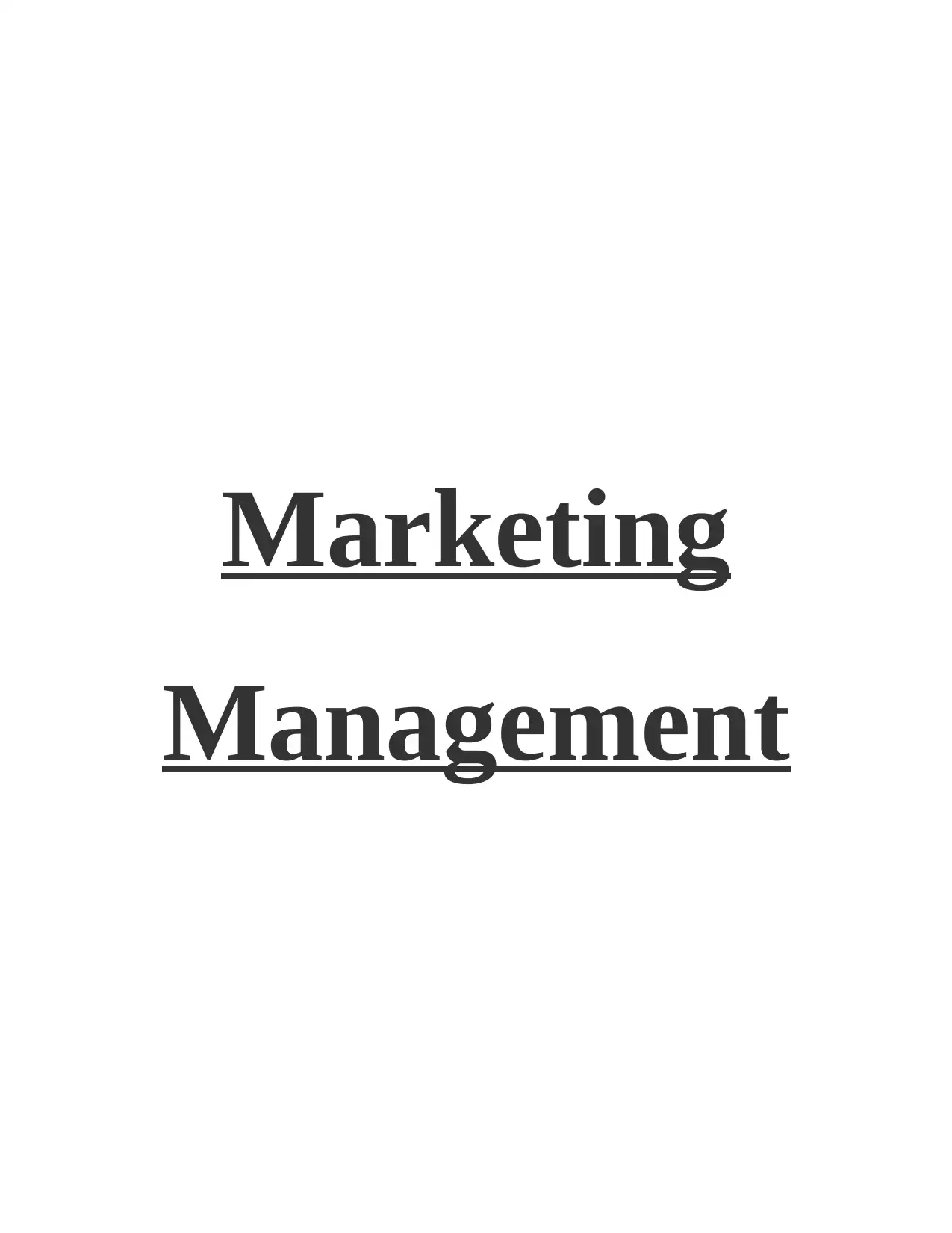
Marketing
Management
Management
Secure Best Marks with AI Grader
Need help grading? Try our AI Grader for instant feedback on your assignments.
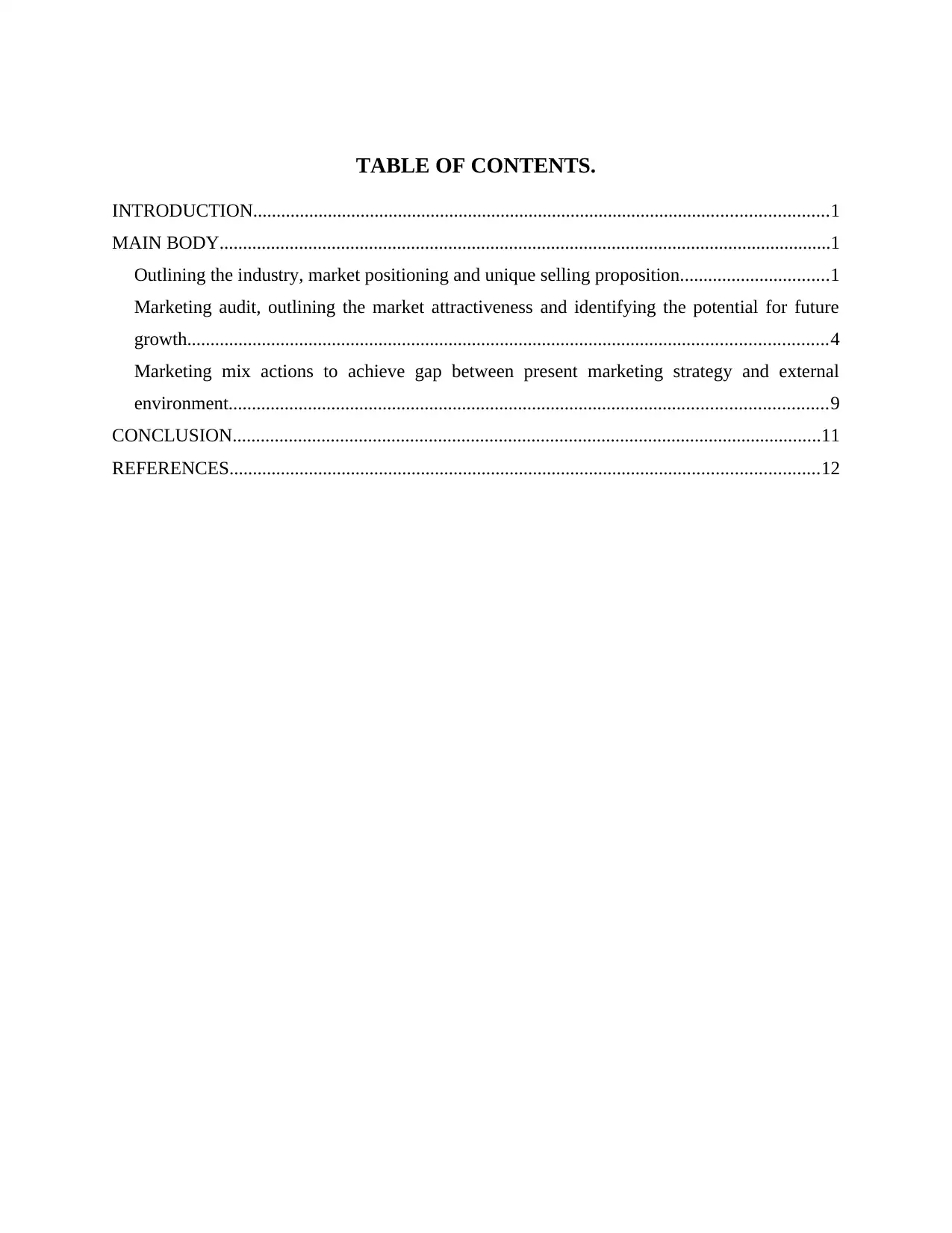
TABLE OF CONTENTS.
INTRODUCTION...........................................................................................................................1
MAIN BODY...................................................................................................................................1
Outlining the industry, market positioning and unique selling proposition................................1
Marketing audit, outlining the market attractiveness and identifying the potential for future
growth.........................................................................................................................................4
Marketing mix actions to achieve gap between present marketing strategy and external
environment................................................................................................................................9
CONCLUSION..............................................................................................................................11
REFERENCES..............................................................................................................................12
INTRODUCTION...........................................................................................................................1
MAIN BODY...................................................................................................................................1
Outlining the industry, market positioning and unique selling proposition................................1
Marketing audit, outlining the market attractiveness and identifying the potential for future
growth.........................................................................................................................................4
Marketing mix actions to achieve gap between present marketing strategy and external
environment................................................................................................................................9
CONCLUSION..............................................................................................................................11
REFERENCES..............................................................................................................................12

INTRODUCTION
Marketing management is concerned with the analysis, planning, implementation and
controlling of all the programmes that are designed to produce desired products and services for
the achievement of organizational goals and objectives. Marketing management is considered to
be an effective process for the growth of an organization as it helps in reducing the cost and
maximizing the profits. It has become imperative for every company to perform marketing
management if they wish to achieve competitive advantage in the long run. Founded in the year
2006, Reliance retail is a subsidiary of Reliance Industries limited and is said to be the largest
retailer in the country in terms of revenue. The company initially started off with just one store in
Mumbai but as of 2019, it has more than 10800 stores located across the country. The company
generates employment to more than 100,000 people and has diversified its operations through
opening branches like Reliance digital, Reliance trends, Reliance fresh and Hamleys. The current
study will highlight the importance of marketing management in building customer loyalty,
contribution of market positioning and marketing audit in the growth of Reliance and the new
marketing mix actions to achieve the goals and objectives effectively and efficiently.
MAIN BODY
Outlining the industry, market positioning and unique selling proposition.
Reliance retail is a leading food retailer company in India with a huge market share and
the company has 10800 stores across India that not only sell food items but also provide other
products and services like technology, clothing, household items and groceries. Although, the
company operates in a competitive environment but the unique marketing strategy of Reliance
has helped it in achieving an edge over other players in the industry. The organization has always
focused on providing innovative services to its customers at economic prices which has not
helped in attracting new customers but also helped the company in retaining its previous
customers thus leading to customer loyalty. Moreover, the company has always maintained good
relations with its suppliers which has helped them in allocating good quality raw materials at
competitive prices which has further helped in maximizing its profitability. Reliance group
achieved competitive advantage in this highly competitive industry through:
Diversification: The major reason behind the growth of the organization has been its
diversification strategies. The company initially started off as a food selling store but later
1
Marketing management is concerned with the analysis, planning, implementation and
controlling of all the programmes that are designed to produce desired products and services for
the achievement of organizational goals and objectives. Marketing management is considered to
be an effective process for the growth of an organization as it helps in reducing the cost and
maximizing the profits. It has become imperative for every company to perform marketing
management if they wish to achieve competitive advantage in the long run. Founded in the year
2006, Reliance retail is a subsidiary of Reliance Industries limited and is said to be the largest
retailer in the country in terms of revenue. The company initially started off with just one store in
Mumbai but as of 2019, it has more than 10800 stores located across the country. The company
generates employment to more than 100,000 people and has diversified its operations through
opening branches like Reliance digital, Reliance trends, Reliance fresh and Hamleys. The current
study will highlight the importance of marketing management in building customer loyalty,
contribution of market positioning and marketing audit in the growth of Reliance and the new
marketing mix actions to achieve the goals and objectives effectively and efficiently.
MAIN BODY
Outlining the industry, market positioning and unique selling proposition.
Reliance retail is a leading food retailer company in India with a huge market share and
the company has 10800 stores across India that not only sell food items but also provide other
products and services like technology, clothing, household items and groceries. Although, the
company operates in a competitive environment but the unique marketing strategy of Reliance
has helped it in achieving an edge over other players in the industry. The organization has always
focused on providing innovative services to its customers at economic prices which has not
helped in attracting new customers but also helped the company in retaining its previous
customers thus leading to customer loyalty. Moreover, the company has always maintained good
relations with its suppliers which has helped them in allocating good quality raw materials at
competitive prices which has further helped in maximizing its profitability. Reliance group
achieved competitive advantage in this highly competitive industry through:
Diversification: The major reason behind the growth of the organization has been its
diversification strategies. The company initially started off as a food selling store but later
1
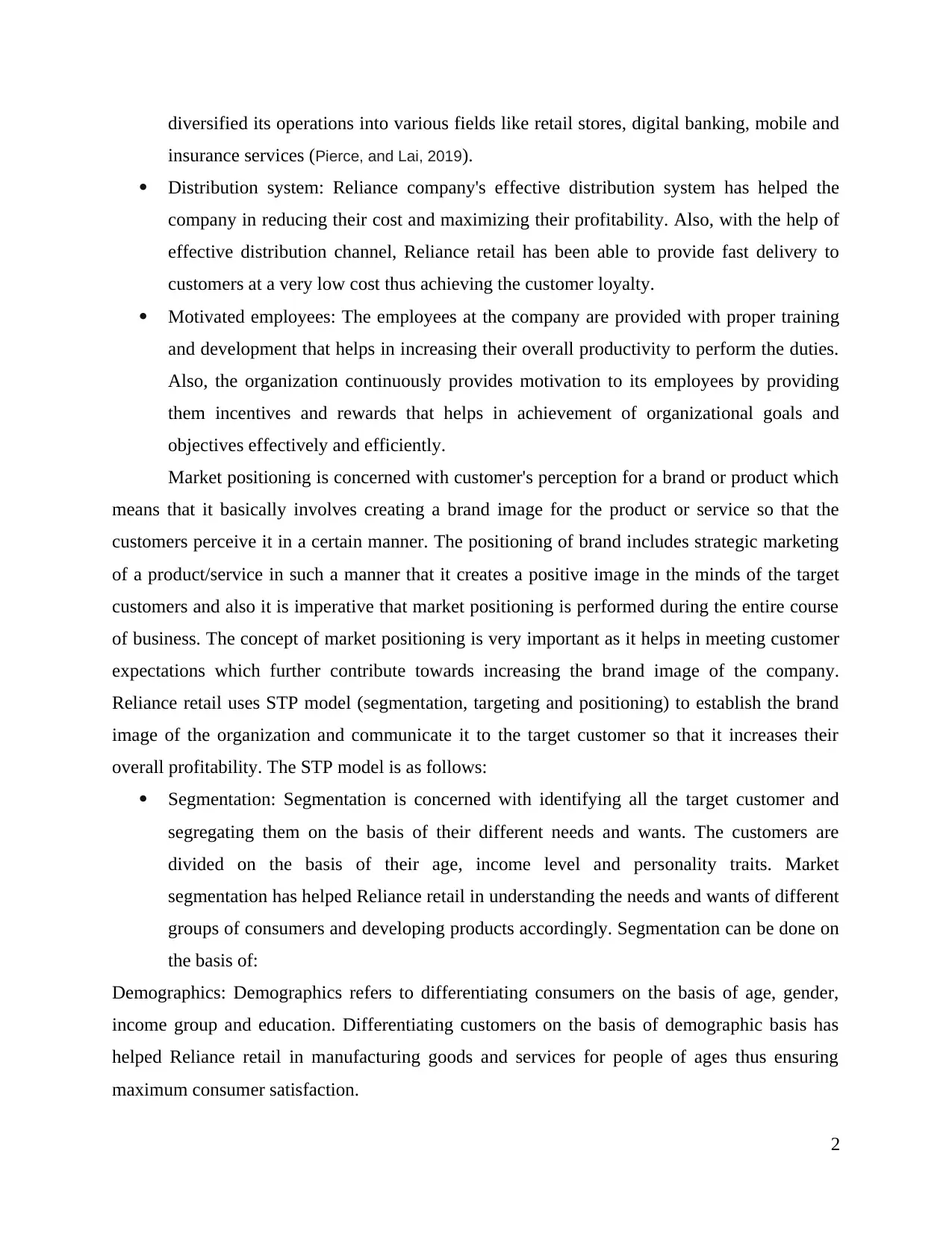
diversified its operations into various fields like retail stores, digital banking, mobile and
insurance services (Pierce, and Lai, 2019).
Distribution system: Reliance company's effective distribution system has helped the
company in reducing their cost and maximizing their profitability. Also, with the help of
effective distribution channel, Reliance retail has been able to provide fast delivery to
customers at a very low cost thus achieving the customer loyalty.
Motivated employees: The employees at the company are provided with proper training
and development that helps in increasing their overall productivity to perform the duties.
Also, the organization continuously provides motivation to its employees by providing
them incentives and rewards that helps in achievement of organizational goals and
objectives effectively and efficiently.
Market positioning is concerned with customer's perception for a brand or product which
means that it basically involves creating a brand image for the product or service so that the
customers perceive it in a certain manner. The positioning of brand includes strategic marketing
of a product/service in such a manner that it creates a positive image in the minds of the target
customers and also it is imperative that market positioning is performed during the entire course
of business. The concept of market positioning is very important as it helps in meeting customer
expectations which further contribute towards increasing the brand image of the company.
Reliance retail uses STP model (segmentation, targeting and positioning) to establish the brand
image of the organization and communicate it to the target customer so that it increases their
overall profitability. The STP model is as follows:
Segmentation: Segmentation is concerned with identifying all the target customer and
segregating them on the basis of their different needs and wants. The customers are
divided on the basis of their age, income level and personality traits. Market
segmentation has helped Reliance retail in understanding the needs and wants of different
groups of consumers and developing products accordingly. Segmentation can be done on
the basis of:
Demographics: Demographics refers to differentiating consumers on the basis of age, gender,
income group and education. Differentiating customers on the basis of demographic basis has
helped Reliance retail in manufacturing goods and services for people of ages thus ensuring
maximum consumer satisfaction.
2
insurance services (Pierce, and Lai, 2019).
Distribution system: Reliance company's effective distribution system has helped the
company in reducing their cost and maximizing their profitability. Also, with the help of
effective distribution channel, Reliance retail has been able to provide fast delivery to
customers at a very low cost thus achieving the customer loyalty.
Motivated employees: The employees at the company are provided with proper training
and development that helps in increasing their overall productivity to perform the duties.
Also, the organization continuously provides motivation to its employees by providing
them incentives and rewards that helps in achievement of organizational goals and
objectives effectively and efficiently.
Market positioning is concerned with customer's perception for a brand or product which
means that it basically involves creating a brand image for the product or service so that the
customers perceive it in a certain manner. The positioning of brand includes strategic marketing
of a product/service in such a manner that it creates a positive image in the minds of the target
customers and also it is imperative that market positioning is performed during the entire course
of business. The concept of market positioning is very important as it helps in meeting customer
expectations which further contribute towards increasing the brand image of the company.
Reliance retail uses STP model (segmentation, targeting and positioning) to establish the brand
image of the organization and communicate it to the target customer so that it increases their
overall profitability. The STP model is as follows:
Segmentation: Segmentation is concerned with identifying all the target customer and
segregating them on the basis of their different needs and wants. The customers are
divided on the basis of their age, income level and personality traits. Market
segmentation has helped Reliance retail in understanding the needs and wants of different
groups of consumers and developing products accordingly. Segmentation can be done on
the basis of:
Demographics: Demographics refers to differentiating consumers on the basis of age, gender,
income group and education. Differentiating customers on the basis of demographic basis has
helped Reliance retail in manufacturing goods and services for people of ages thus ensuring
maximum consumer satisfaction.
2
Paraphrase This Document
Need a fresh take? Get an instant paraphrase of this document with our AI Paraphraser
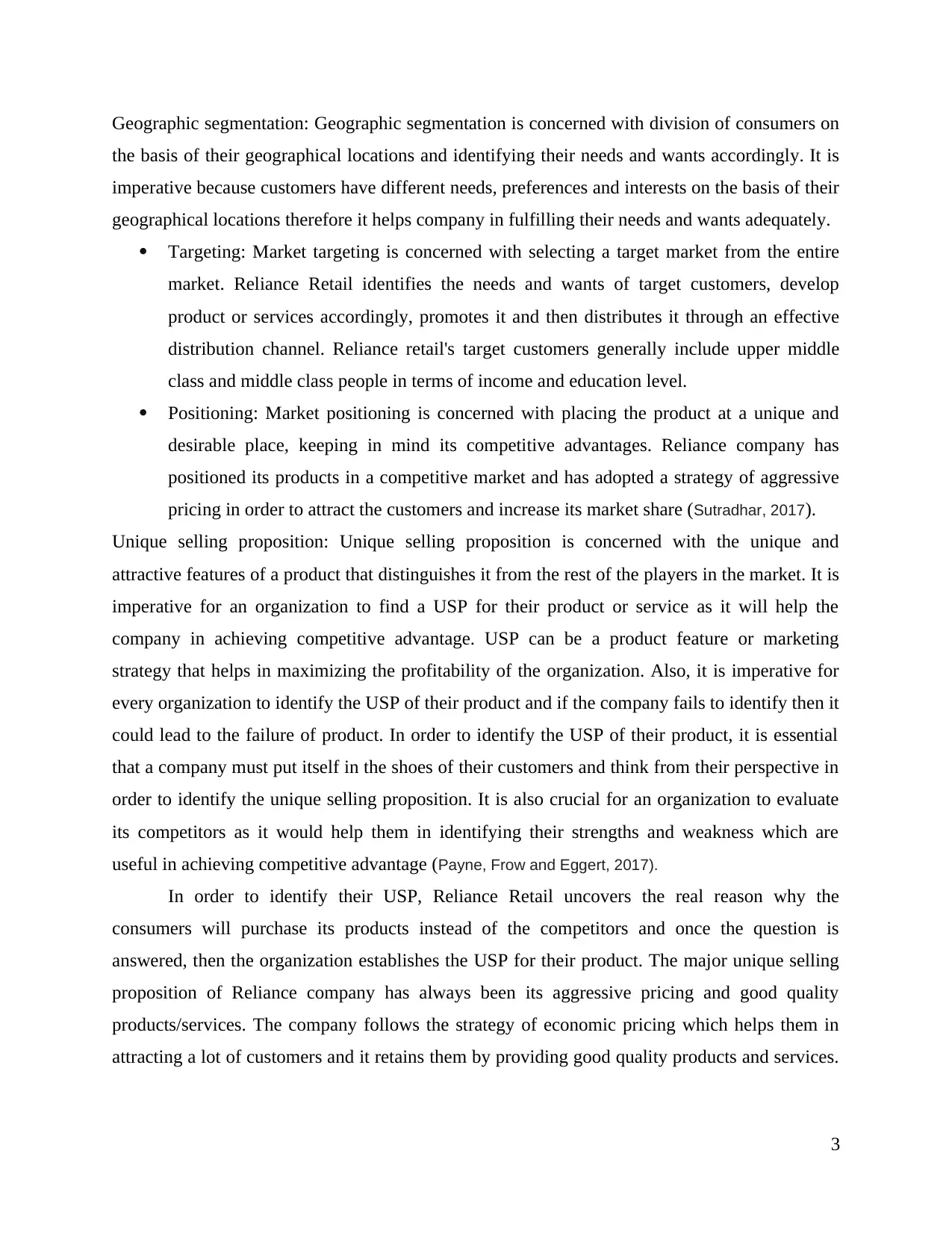
Geographic segmentation: Geographic segmentation is concerned with division of consumers on
the basis of their geographical locations and identifying their needs and wants accordingly. It is
imperative because customers have different needs, preferences and interests on the basis of their
geographical locations therefore it helps company in fulfilling their needs and wants adequately.
Targeting: Market targeting is concerned with selecting a target market from the entire
market. Reliance Retail identifies the needs and wants of target customers, develop
product or services accordingly, promotes it and then distributes it through an effective
distribution channel. Reliance retail's target customers generally include upper middle
class and middle class people in terms of income and education level.
Positioning: Market positioning is concerned with placing the product at a unique and
desirable place, keeping in mind its competitive advantages. Reliance company has
positioned its products in a competitive market and has adopted a strategy of aggressive
pricing in order to attract the customers and increase its market share (Sutradhar, 2017).
Unique selling proposition: Unique selling proposition is concerned with the unique and
attractive features of a product that distinguishes it from the rest of the players in the market. It is
imperative for an organization to find a USP for their product or service as it will help the
company in achieving competitive advantage. USP can be a product feature or marketing
strategy that helps in maximizing the profitability of the organization. Also, it is imperative for
every organization to identify the USP of their product and if the company fails to identify then it
could lead to the failure of product. In order to identify the USP of their product, it is essential
that a company must put itself in the shoes of their customers and think from their perspective in
order to identify the unique selling proposition. It is also crucial for an organization to evaluate
its competitors as it would help them in identifying their strengths and weakness which are
useful in achieving competitive advantage (Payne, Frow and Eggert, 2017).
In order to identify their USP, Reliance Retail uncovers the real reason why the
consumers will purchase its products instead of the competitors and once the question is
answered, then the organization establishes the USP for their product. The major unique selling
proposition of Reliance company has always been its aggressive pricing and good quality
products/services. The company follows the strategy of economic pricing which helps them in
attracting a lot of customers and it retains them by providing good quality products and services.
3
the basis of their geographical locations and identifying their needs and wants accordingly. It is
imperative because customers have different needs, preferences and interests on the basis of their
geographical locations therefore it helps company in fulfilling their needs and wants adequately.
Targeting: Market targeting is concerned with selecting a target market from the entire
market. Reliance Retail identifies the needs and wants of target customers, develop
product or services accordingly, promotes it and then distributes it through an effective
distribution channel. Reliance retail's target customers generally include upper middle
class and middle class people in terms of income and education level.
Positioning: Market positioning is concerned with placing the product at a unique and
desirable place, keeping in mind its competitive advantages. Reliance company has
positioned its products in a competitive market and has adopted a strategy of aggressive
pricing in order to attract the customers and increase its market share (Sutradhar, 2017).
Unique selling proposition: Unique selling proposition is concerned with the unique and
attractive features of a product that distinguishes it from the rest of the players in the market. It is
imperative for an organization to find a USP for their product or service as it will help the
company in achieving competitive advantage. USP can be a product feature or marketing
strategy that helps in maximizing the profitability of the organization. Also, it is imperative for
every organization to identify the USP of their product and if the company fails to identify then it
could lead to the failure of product. In order to identify the USP of their product, it is essential
that a company must put itself in the shoes of their customers and think from their perspective in
order to identify the unique selling proposition. It is also crucial for an organization to evaluate
its competitors as it would help them in identifying their strengths and weakness which are
useful in achieving competitive advantage (Payne, Frow and Eggert, 2017).
In order to identify their USP, Reliance Retail uncovers the real reason why the
consumers will purchase its products instead of the competitors and once the question is
answered, then the organization establishes the USP for their product. The major unique selling
proposition of Reliance company has always been its aggressive pricing and good quality
products/services. The company follows the strategy of economic pricing which helps them in
attracting a lot of customers and it retains them by providing good quality products and services.
3
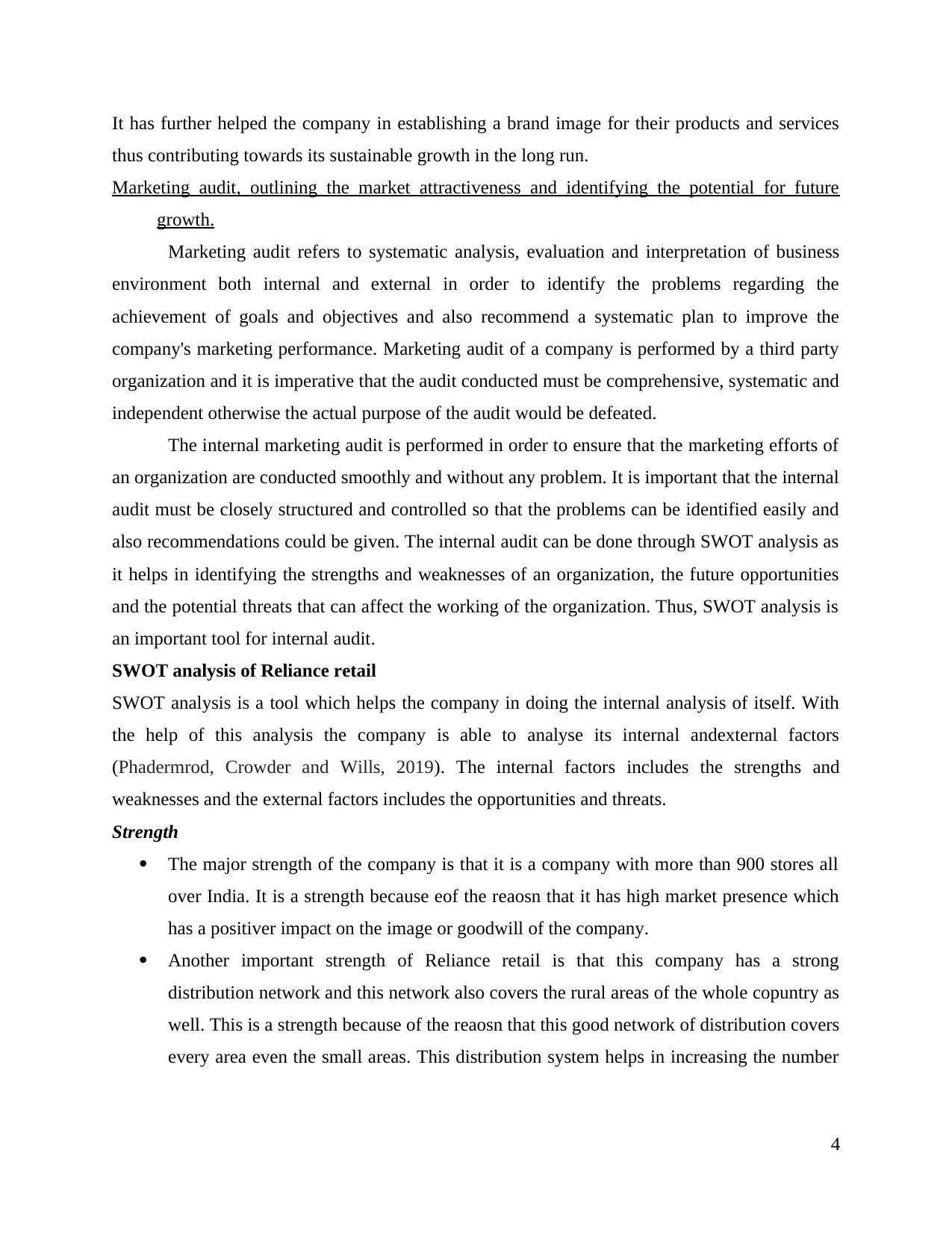
It has further helped the company in establishing a brand image for their products and services
thus contributing towards its sustainable growth in the long run.
Marketing audit, outlining the market attractiveness and identifying the potential for future
growth.
Marketing audit refers to systematic analysis, evaluation and interpretation of business
environment both internal and external in order to identify the problems regarding the
achievement of goals and objectives and also recommend a systematic plan to improve the
company's marketing performance. Marketing audit of a company is performed by a third party
organization and it is imperative that the audit conducted must be comprehensive, systematic and
independent otherwise the actual purpose of the audit would be defeated.
The internal marketing audit is performed in order to ensure that the marketing efforts of
an organization are conducted smoothly and without any problem. It is important that the internal
audit must be closely structured and controlled so that the problems can be identified easily and
also recommendations could be given. The internal audit can be done through SWOT analysis as
it helps in identifying the strengths and weaknesses of an organization, the future opportunities
and the potential threats that can affect the working of the organization. Thus, SWOT analysis is
an important tool for internal audit.
SWOT analysis of Reliance retail
SWOT analysis is a tool which helps the company in doing the internal analysis of itself. With
the help of this analysis the company is able to analyse its internal andexternal factors
(Phadermrod, Crowder and Wills, 2019). The internal factors includes the strengths and
weaknesses and the external factors includes the opportunities and threats.
Strength
The major strength of the company is that it is a company with more than 900 stores all
over India. It is a strength because eof the reaosn that it has high market presence which
has a positiver impact on the image or goodwill of the company.
Another important strength of Reliance retail is that this company has a strong
distribution network and this network also covers the rural areas of the whole copuntry as
well. This is a strength because of the reaosn that this good network of distribution covers
every area even the small areas. This distribution system helps in increasing the number
4
thus contributing towards its sustainable growth in the long run.
Marketing audit, outlining the market attractiveness and identifying the potential for future
growth.
Marketing audit refers to systematic analysis, evaluation and interpretation of business
environment both internal and external in order to identify the problems regarding the
achievement of goals and objectives and also recommend a systematic plan to improve the
company's marketing performance. Marketing audit of a company is performed by a third party
organization and it is imperative that the audit conducted must be comprehensive, systematic and
independent otherwise the actual purpose of the audit would be defeated.
The internal marketing audit is performed in order to ensure that the marketing efforts of
an organization are conducted smoothly and without any problem. It is important that the internal
audit must be closely structured and controlled so that the problems can be identified easily and
also recommendations could be given. The internal audit can be done through SWOT analysis as
it helps in identifying the strengths and weaknesses of an organization, the future opportunities
and the potential threats that can affect the working of the organization. Thus, SWOT analysis is
an important tool for internal audit.
SWOT analysis of Reliance retail
SWOT analysis is a tool which helps the company in doing the internal analysis of itself. With
the help of this analysis the company is able to analyse its internal andexternal factors
(Phadermrod, Crowder and Wills, 2019). The internal factors includes the strengths and
weaknesses and the external factors includes the opportunities and threats.
Strength
The major strength of the company is that it is a company with more than 900 stores all
over India. It is a strength because eof the reaosn that it has high market presence which
has a positiver impact on the image or goodwill of the company.
Another important strength of Reliance retail is that this company has a strong
distribution network and this network also covers the rural areas of the whole copuntry as
well. This is a strength because of the reaosn that this good network of distribution covers
every area even the small areas. This distribution system helps in increasing the number
4
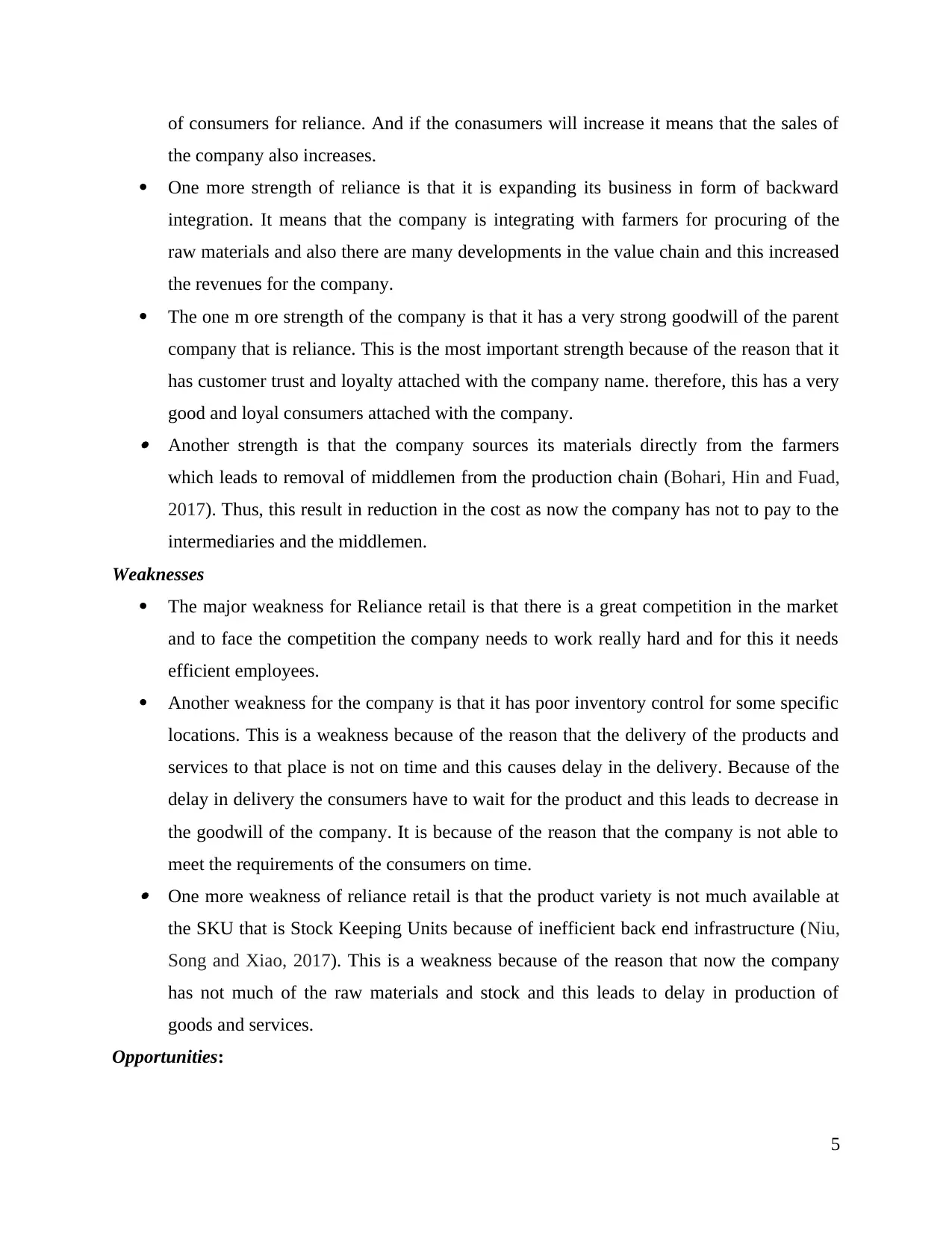
of consumers for reliance. And if the conasumers will increase it means that the sales of
the company also increases.
One more strength of reliance is that it is expanding its business in form of backward
integration. It means that the company is integrating with farmers for procuring of the
raw materials and also there are many developments in the value chain and this increased
the revenues for the company.
The one m ore strength of the company is that it has a very strong goodwill of the parent
company that is reliance. This is the most important strength because of the reason that it
has customer trust and loyalty attached with the company name. therefore, this has a very
good and loyal consumers attached with the company. Another strength is that the company sources its materials directly from the farmers
which leads to removal of middlemen from the production chain (Bohari, Hin and Fuad,
2017). Thus, this result in reduction in the cost as now the company has not to pay to the
intermediaries and the middlemen.
Weaknesses
The major weakness for Reliance retail is that there is a great competition in the market
and to face the competition the company needs to work really hard and for this it needs
efficient employees.
Another weakness for the company is that it has poor inventory control for some specific
locations. This is a weakness because of the reason that the delivery of the products and
services to that place is not on time and this causes delay in the delivery. Because of the
delay in delivery the consumers have to wait for the product and this leads to decrease in
the goodwill of the company. It is because of the reason that the company is not able to
meet the requirements of the consumers on time. One more weakness of reliance retail is that the product variety is not much available at
the SKU that is Stock Keeping Units because of inefficient back end infrastructure (Niu,
Song and Xiao, 2017). This is a weakness because of the reason that now the company
has not much of the raw materials and stock and this leads to delay in production of
goods and services.
Opportunities:
5
the company also increases.
One more strength of reliance is that it is expanding its business in form of backward
integration. It means that the company is integrating with farmers for procuring of the
raw materials and also there are many developments in the value chain and this increased
the revenues for the company.
The one m ore strength of the company is that it has a very strong goodwill of the parent
company that is reliance. This is the most important strength because of the reason that it
has customer trust and loyalty attached with the company name. therefore, this has a very
good and loyal consumers attached with the company. Another strength is that the company sources its materials directly from the farmers
which leads to removal of middlemen from the production chain (Bohari, Hin and Fuad,
2017). Thus, this result in reduction in the cost as now the company has not to pay to the
intermediaries and the middlemen.
Weaknesses
The major weakness for Reliance retail is that there is a great competition in the market
and to face the competition the company needs to work really hard and for this it needs
efficient employees.
Another weakness for the company is that it has poor inventory control for some specific
locations. This is a weakness because of the reason that the delivery of the products and
services to that place is not on time and this causes delay in the delivery. Because of the
delay in delivery the consumers have to wait for the product and this leads to decrease in
the goodwill of the company. It is because of the reason that the company is not able to
meet the requirements of the consumers on time. One more weakness of reliance retail is that the product variety is not much available at
the SKU that is Stock Keeping Units because of inefficient back end infrastructure (Niu,
Song and Xiao, 2017). This is a weakness because of the reason that now the company
has not much of the raw materials and stock and this leads to delay in production of
goods and services.
Opportunities:
5
Secure Best Marks with AI Grader
Need help grading? Try our AI Grader for instant feedback on your assignments.

Reliance Retail has a major opportunity to directly purchase the groceries from farmers
as it would avoid the role of middle men and thus increase the overall profitability of the
company. Also, in a developing country like India the number of farmers have been
rising incessantly therefore it can be a very profitable situation for Reliance company.
Reliance retail must promote its business online in order to attract new customer base and
maximize their profitability. Also, the company must provide unique and attractive offers
online so that it can increase its market share and achieve competitive edge over other
players in the online industry. Certain offers like free delivery of grocery items and
offering rebates and discounts will help the business to grow incessantly (Takata, 2016). The company must use the advantage of its brand name and should enter into
manufacturing of various goods and services. Also, reliance retail must use strong supply
chain networks in order to reduce their overall operations cost thus contributing to the
company's profits.
Threats:
The operating cost of Reliance retail is very high which can hamper their growth
prospects as compared to the organization's competitors. Therefore, it is imperative to
reduce the operating cost in order to survive and grow in the retail industry.
There is a huge possibility that Reliance Retail will receive competition from global retail
stores like Tesco, Walmart as they plan to enter into India. Also, these companies follow
backward integration which can affect the growth prospects of Reliance Retail. Hence,
Reliance Retail must prepare its marketing strategy in order to overcome the international
competition (Zhao, and et.al., 2016).
External marketing audit: External marketing audit is performed to identify the external factors
affecting the performance of the organization. External factors include Political, economic,
social, technological, legal and environmental factors. The PESTLE analysis of Reliance Retail
is as follows:
PESTLE Analysis
Political factors: The political factors include the taxation policy, subsidies and the
political stability in a country. The tax rate on supermarkets is very high in India and it
has demotivated the Reliance Retail from maximizing their profits therefore the political
factors have a negative impact on the smooth working of the company.
6
as it would avoid the role of middle men and thus increase the overall profitability of the
company. Also, in a developing country like India the number of farmers have been
rising incessantly therefore it can be a very profitable situation for Reliance company.
Reliance retail must promote its business online in order to attract new customer base and
maximize their profitability. Also, the company must provide unique and attractive offers
online so that it can increase its market share and achieve competitive edge over other
players in the online industry. Certain offers like free delivery of grocery items and
offering rebates and discounts will help the business to grow incessantly (Takata, 2016). The company must use the advantage of its brand name and should enter into
manufacturing of various goods and services. Also, reliance retail must use strong supply
chain networks in order to reduce their overall operations cost thus contributing to the
company's profits.
Threats:
The operating cost of Reliance retail is very high which can hamper their growth
prospects as compared to the organization's competitors. Therefore, it is imperative to
reduce the operating cost in order to survive and grow in the retail industry.
There is a huge possibility that Reliance Retail will receive competition from global retail
stores like Tesco, Walmart as they plan to enter into India. Also, these companies follow
backward integration which can affect the growth prospects of Reliance Retail. Hence,
Reliance Retail must prepare its marketing strategy in order to overcome the international
competition (Zhao, and et.al., 2016).
External marketing audit: External marketing audit is performed to identify the external factors
affecting the performance of the organization. External factors include Political, economic,
social, technological, legal and environmental factors. The PESTLE analysis of Reliance Retail
is as follows:
PESTLE Analysis
Political factors: The political factors include the taxation policy, subsidies and the
political stability in a country. The tax rate on supermarkets is very high in India and it
has demotivated the Reliance Retail from maximizing their profits therefore the political
factors have a negative impact on the smooth working of the company.
6

Economic factors: Economic factors include the inflation rate, rate of interest, GDP and
current stage of economic cycle. The economic boom in the country and balanced
regional development has helped the company in increasing their sales as well as market
share. As of 2019, Reliance retail has established 10000 stores across the India thus the
economic factors have positively impacted the working of retail industry.
Social factors: Social factors are concerned with the cultural values, buying habits,
income level and age group of the people of country (Takata, 2016). With the increasing
use of internet and smart phones even in the remote areas of the country has increased the
sales of Reliance Jio and the company has established several mobile retail stores in
villages which has increased their customer base and market share. The social factors
have positively affected the Reliance Retail and has maximized their profits incessantly.
Technological factors: It is imperative to use latest and modern technology in order to
reduce the cost of operations and maximize the overall profits of the company. Reliance
Retail uses the latest technology like artificial intelligence to identify the taste and
preferences of consumers, use of integrated inventory management system to keep a
close check on the deficit and surplus goods and services and also online services to order
products and providing free home delivery along with tracking facility. The JIO retail
store verifies the user details just by scanning the fingerprints and then provides the SIM
cards to customers. All these factors enhance the overall customer experience and
increases the revenue of the company.
Legal factors: Legal factors include the rules and regulations that a company has to abide
by in order to avoid government intervention. Although, Reliance retail follows all the
legal policies and have all the legal licence like FSSAI, drug licence and TRAI certificate
but the Retail giant has still faced some problems that have affected the brand image of
the company.
Environmental factors: Reliance Industries follow their social duties in order to protect
and preserve the environment. The company promotes the use of paper bags instead of
plastic polythene as it harms the atmosphere. The company, as a part of its corporate
social responsibility has established various charitable trusts in order to take care of the
environment (Rastogi, N.I.T.A.N.K. and Trivedi, 2016).
7
current stage of economic cycle. The economic boom in the country and balanced
regional development has helped the company in increasing their sales as well as market
share. As of 2019, Reliance retail has established 10000 stores across the India thus the
economic factors have positively impacted the working of retail industry.
Social factors: Social factors are concerned with the cultural values, buying habits,
income level and age group of the people of country (Takata, 2016). With the increasing
use of internet and smart phones even in the remote areas of the country has increased the
sales of Reliance Jio and the company has established several mobile retail stores in
villages which has increased their customer base and market share. The social factors
have positively affected the Reliance Retail and has maximized their profits incessantly.
Technological factors: It is imperative to use latest and modern technology in order to
reduce the cost of operations and maximize the overall profits of the company. Reliance
Retail uses the latest technology like artificial intelligence to identify the taste and
preferences of consumers, use of integrated inventory management system to keep a
close check on the deficit and surplus goods and services and also online services to order
products and providing free home delivery along with tracking facility. The JIO retail
store verifies the user details just by scanning the fingerprints and then provides the SIM
cards to customers. All these factors enhance the overall customer experience and
increases the revenue of the company.
Legal factors: Legal factors include the rules and regulations that a company has to abide
by in order to avoid government intervention. Although, Reliance retail follows all the
legal policies and have all the legal licence like FSSAI, drug licence and TRAI certificate
but the Retail giant has still faced some problems that have affected the brand image of
the company.
Environmental factors: Reliance Industries follow their social duties in order to protect
and preserve the environment. The company promotes the use of paper bags instead of
plastic polythene as it harms the atmosphere. The company, as a part of its corporate
social responsibility has established various charitable trusts in order to take care of the
environment (Rastogi, N.I.T.A.N.K. and Trivedi, 2016).
7
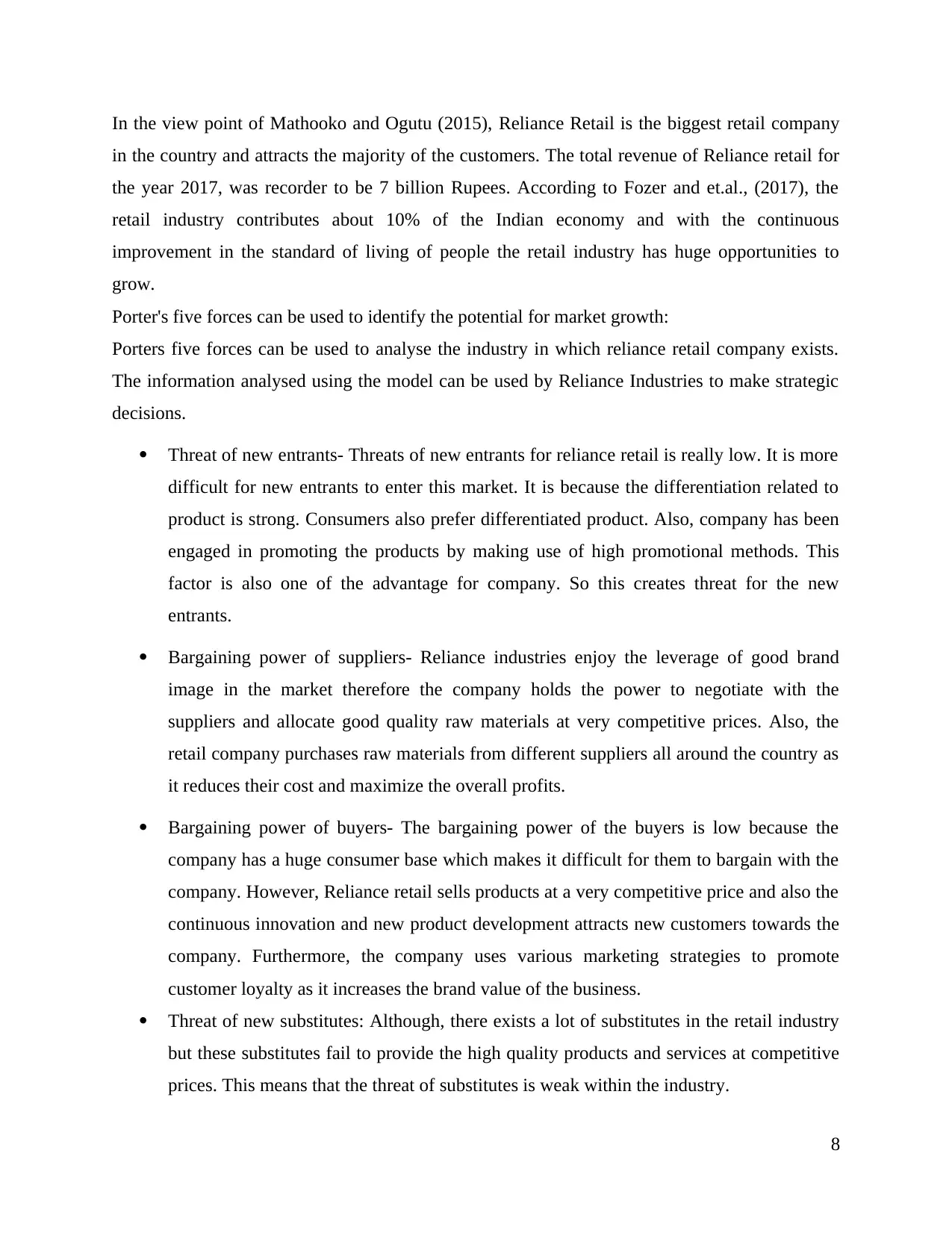
In the view point of Mathooko and Ogutu (2015), Reliance Retail is the biggest retail company
in the country and attracts the majority of the customers. The total revenue of Reliance retail for
the year 2017, was recorder to be 7 billion Rupees. According to Fozer and et.al., (2017), the
retail industry contributes about 10% of the Indian economy and with the continuous
improvement in the standard of living of people the retail industry has huge opportunities to
grow.
Porter's five forces can be used to identify the potential for market growth:
Porters five forces can be used to analyse the industry in which reliance retail company exists.
The information analysed using the model can be used by Reliance Industries to make strategic
decisions.
Threat of new entrants- Threats of new entrants for reliance retail is really low. It is more
difficult for new entrants to enter this market. It is because the differentiation related to
product is strong. Consumers also prefer differentiated product. Also, company has been
engaged in promoting the products by making use of high promotional methods. This
factor is also one of the advantage for company. So this creates threat for the new
entrants.
Bargaining power of suppliers- Reliance industries enjoy the leverage of good brand
image in the market therefore the company holds the power to negotiate with the
suppliers and allocate good quality raw materials at very competitive prices. Also, the
retail company purchases raw materials from different suppliers all around the country as
it reduces their cost and maximize the overall profits.
Bargaining power of buyers- The bargaining power of the buyers is low because the
company has a huge consumer base which makes it difficult for them to bargain with the
company. However, Reliance retail sells products at a very competitive price and also the
continuous innovation and new product development attracts new customers towards the
company. Furthermore, the company uses various marketing strategies to promote
customer loyalty as it increases the brand value of the business.
Threat of new substitutes: Although, there exists a lot of substitutes in the retail industry
but these substitutes fail to provide the high quality products and services at competitive
prices. This means that the threat of substitutes is weak within the industry.
8
in the country and attracts the majority of the customers. The total revenue of Reliance retail for
the year 2017, was recorder to be 7 billion Rupees. According to Fozer and et.al., (2017), the
retail industry contributes about 10% of the Indian economy and with the continuous
improvement in the standard of living of people the retail industry has huge opportunities to
grow.
Porter's five forces can be used to identify the potential for market growth:
Porters five forces can be used to analyse the industry in which reliance retail company exists.
The information analysed using the model can be used by Reliance Industries to make strategic
decisions.
Threat of new entrants- Threats of new entrants for reliance retail is really low. It is more
difficult for new entrants to enter this market. It is because the differentiation related to
product is strong. Consumers also prefer differentiated product. Also, company has been
engaged in promoting the products by making use of high promotional methods. This
factor is also one of the advantage for company. So this creates threat for the new
entrants.
Bargaining power of suppliers- Reliance industries enjoy the leverage of good brand
image in the market therefore the company holds the power to negotiate with the
suppliers and allocate good quality raw materials at very competitive prices. Also, the
retail company purchases raw materials from different suppliers all around the country as
it reduces their cost and maximize the overall profits.
Bargaining power of buyers- The bargaining power of the buyers is low because the
company has a huge consumer base which makes it difficult for them to bargain with the
company. However, Reliance retail sells products at a very competitive price and also the
continuous innovation and new product development attracts new customers towards the
company. Furthermore, the company uses various marketing strategies to promote
customer loyalty as it increases the brand value of the business.
Threat of new substitutes: Although, there exists a lot of substitutes in the retail industry
but these substitutes fail to provide the high quality products and services at competitive
prices. This means that the threat of substitutes is weak within the industry.
8
Paraphrase This Document
Need a fresh take? Get an instant paraphrase of this document with our AI Paraphraser
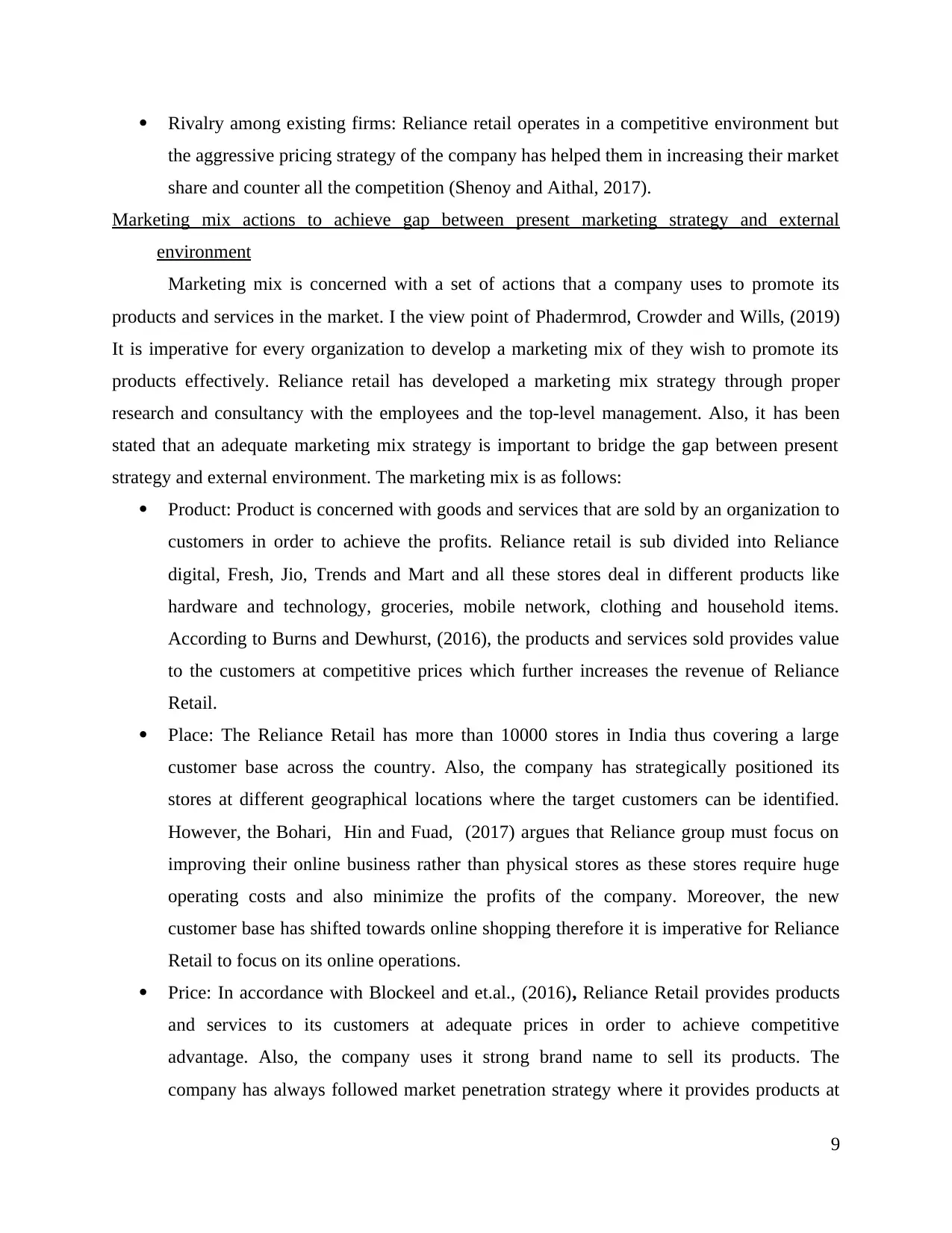
Rivalry among existing firms: Reliance retail operates in a competitive environment but
the aggressive pricing strategy of the company has helped them in increasing their market
share and counter all the competition (Shenoy and Aithal, 2017).
Marketing mix actions to achieve gap between present marketing strategy and external
environment
Marketing mix is concerned with a set of actions that a company uses to promote its
products and services in the market. I the view point of Phadermrod, Crowder and Wills, (2019)
It is imperative for every organization to develop a marketing mix of they wish to promote its
products effectively. Reliance retail has developed a marketing mix strategy through proper
research and consultancy with the employees and the top-level management. Also, it has been
stated that an adequate marketing mix strategy is important to bridge the gap between present
strategy and external environment. The marketing mix is as follows:
Product: Product is concerned with goods and services that are sold by an organization to
customers in order to achieve the profits. Reliance retail is sub divided into Reliance
digital, Fresh, Jio, Trends and Mart and all these stores deal in different products like
hardware and technology, groceries, mobile network, clothing and household items.
According to Burns and Dewhurst, (2016), the products and services sold provides value
to the customers at competitive prices which further increases the revenue of Reliance
Retail.
Place: The Reliance Retail has more than 10000 stores in India thus covering a large
customer base across the country. Also, the company has strategically positioned its
stores at different geographical locations where the target customers can be identified.
However, the Bohari, Hin and Fuad, (2017) argues that Reliance group must focus on
improving their online business rather than physical stores as these stores require huge
operating costs and also minimize the profits of the company. Moreover, the new
customer base has shifted towards online shopping therefore it is imperative for Reliance
Retail to focus on its online operations.
Price: In accordance with Blockeel and et.al., (2016), Reliance Retail provides products
and services to its customers at adequate prices in order to achieve competitive
advantage. Also, the company uses it strong brand name to sell its products. The
company has always followed market penetration strategy where it provides products at
9
the aggressive pricing strategy of the company has helped them in increasing their market
share and counter all the competition (Shenoy and Aithal, 2017).
Marketing mix actions to achieve gap between present marketing strategy and external
environment
Marketing mix is concerned with a set of actions that a company uses to promote its
products and services in the market. I the view point of Phadermrod, Crowder and Wills, (2019)
It is imperative for every organization to develop a marketing mix of they wish to promote its
products effectively. Reliance retail has developed a marketing mix strategy through proper
research and consultancy with the employees and the top-level management. Also, it has been
stated that an adequate marketing mix strategy is important to bridge the gap between present
strategy and external environment. The marketing mix is as follows:
Product: Product is concerned with goods and services that are sold by an organization to
customers in order to achieve the profits. Reliance retail is sub divided into Reliance
digital, Fresh, Jio, Trends and Mart and all these stores deal in different products like
hardware and technology, groceries, mobile network, clothing and household items.
According to Burns and Dewhurst, (2016), the products and services sold provides value
to the customers at competitive prices which further increases the revenue of Reliance
Retail.
Place: The Reliance Retail has more than 10000 stores in India thus covering a large
customer base across the country. Also, the company has strategically positioned its
stores at different geographical locations where the target customers can be identified.
However, the Bohari, Hin and Fuad, (2017) argues that Reliance group must focus on
improving their online business rather than physical stores as these stores require huge
operating costs and also minimize the profits of the company. Moreover, the new
customer base has shifted towards online shopping therefore it is imperative for Reliance
Retail to focus on its online operations.
Price: In accordance with Blockeel and et.al., (2016), Reliance Retail provides products
and services to its customers at adequate prices in order to achieve competitive
advantage. Also, the company uses it strong brand name to sell its products. The
company has always followed market penetration strategy where it provides products at
9
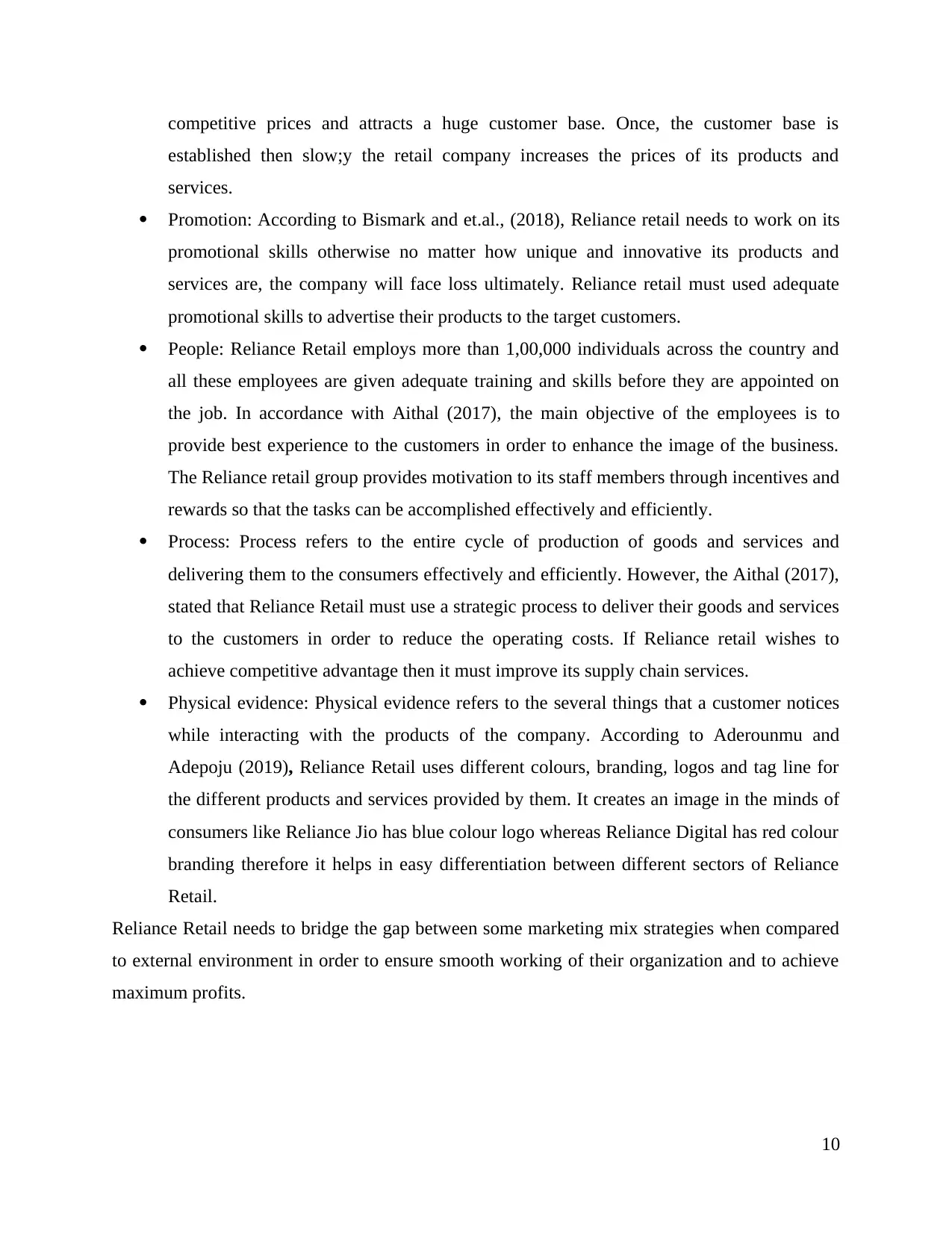
competitive prices and attracts a huge customer base. Once, the customer base is
established then slow;y the retail company increases the prices of its products and
services.
Promotion: According to Bismark and et.al., (2018), Reliance retail needs to work on its
promotional skills otherwise no matter how unique and innovative its products and
services are, the company will face loss ultimately. Reliance retail must used adequate
promotional skills to advertise their products to the target customers.
People: Reliance Retail employs more than 1,00,000 individuals across the country and
all these employees are given adequate training and skills before they are appointed on
the job. In accordance with Aithal (2017), the main objective of the employees is to
provide best experience to the customers in order to enhance the image of the business.
The Reliance retail group provides motivation to its staff members through incentives and
rewards so that the tasks can be accomplished effectively and efficiently.
Process: Process refers to the entire cycle of production of goods and services and
delivering them to the consumers effectively and efficiently. However, the Aithal (2017),
stated that Reliance Retail must use a strategic process to deliver their goods and services
to the customers in order to reduce the operating costs. If Reliance retail wishes to
achieve competitive advantage then it must improve its supply chain services.
Physical evidence: Physical evidence refers to the several things that a customer notices
while interacting with the products of the company. According to Aderounmu and
Adepoju (2019), Reliance Retail uses different colours, branding, logos and tag line for
the different products and services provided by them. It creates an image in the minds of
consumers like Reliance Jio has blue colour logo whereas Reliance Digital has red colour
branding therefore it helps in easy differentiation between different sectors of Reliance
Retail.
Reliance Retail needs to bridge the gap between some marketing mix strategies when compared
to external environment in order to ensure smooth working of their organization and to achieve
maximum profits.
10
established then slow;y the retail company increases the prices of its products and
services.
Promotion: According to Bismark and et.al., (2018), Reliance retail needs to work on its
promotional skills otherwise no matter how unique and innovative its products and
services are, the company will face loss ultimately. Reliance retail must used adequate
promotional skills to advertise their products to the target customers.
People: Reliance Retail employs more than 1,00,000 individuals across the country and
all these employees are given adequate training and skills before they are appointed on
the job. In accordance with Aithal (2017), the main objective of the employees is to
provide best experience to the customers in order to enhance the image of the business.
The Reliance retail group provides motivation to its staff members through incentives and
rewards so that the tasks can be accomplished effectively and efficiently.
Process: Process refers to the entire cycle of production of goods and services and
delivering them to the consumers effectively and efficiently. However, the Aithal (2017),
stated that Reliance Retail must use a strategic process to deliver their goods and services
to the customers in order to reduce the operating costs. If Reliance retail wishes to
achieve competitive advantage then it must improve its supply chain services.
Physical evidence: Physical evidence refers to the several things that a customer notices
while interacting with the products of the company. According to Aderounmu and
Adepoju (2019), Reliance Retail uses different colours, branding, logos and tag line for
the different products and services provided by them. It creates an image in the minds of
consumers like Reliance Jio has blue colour logo whereas Reliance Digital has red colour
branding therefore it helps in easy differentiation between different sectors of Reliance
Retail.
Reliance Retail needs to bridge the gap between some marketing mix strategies when compared
to external environment in order to ensure smooth working of their organization and to achieve
maximum profits.
10
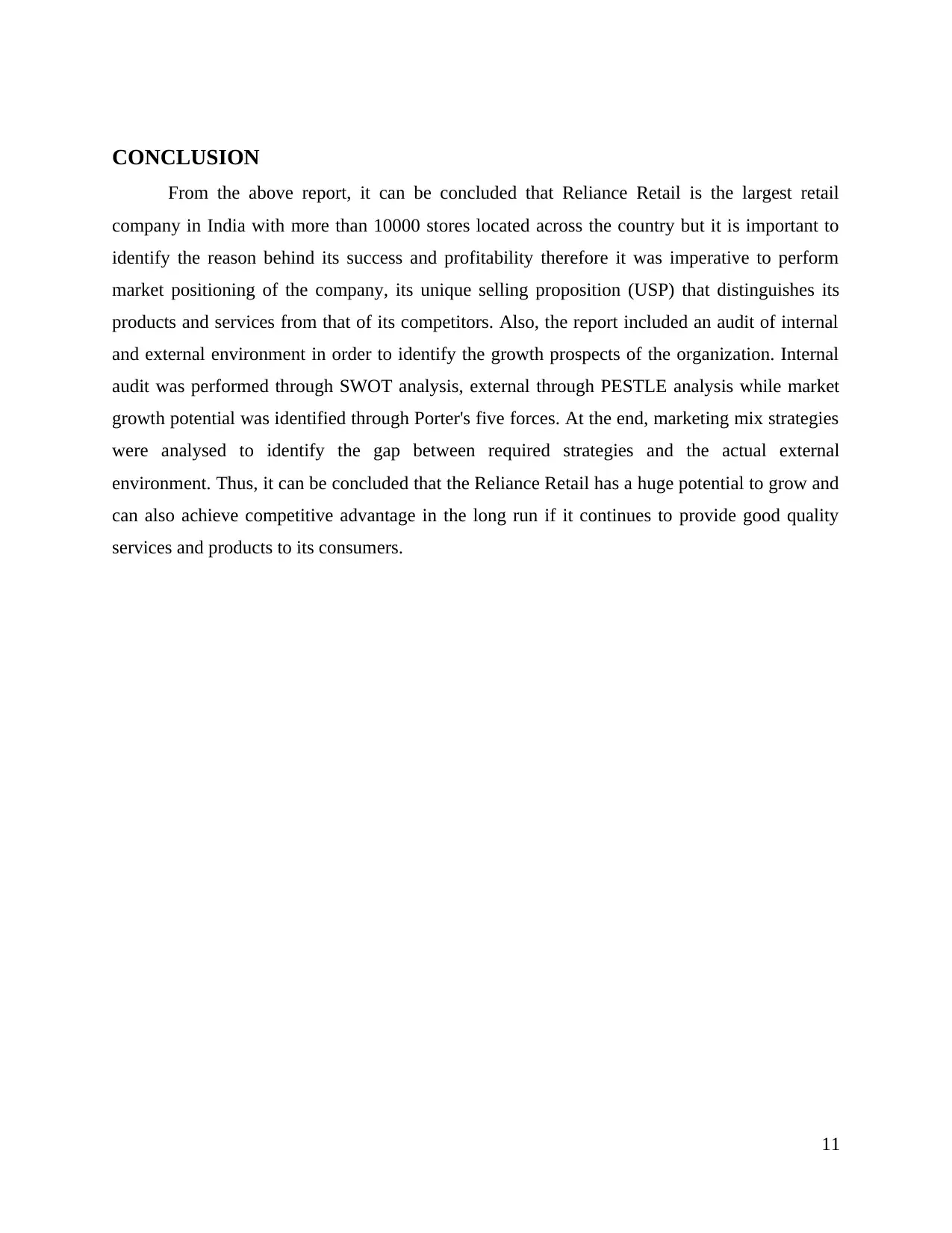
CONCLUSION
From the above report, it can be concluded that Reliance Retail is the largest retail
company in India with more than 10000 stores located across the country but it is important to
identify the reason behind its success and profitability therefore it was imperative to perform
market positioning of the company, its unique selling proposition (USP) that distinguishes its
products and services from that of its competitors. Also, the report included an audit of internal
and external environment in order to identify the growth prospects of the organization. Internal
audit was performed through SWOT analysis, external through PESTLE analysis while market
growth potential was identified through Porter's five forces. At the end, marketing mix strategies
were analysed to identify the gap between required strategies and the actual external
environment. Thus, it can be concluded that the Reliance Retail has a huge potential to grow and
can also achieve competitive advantage in the long run if it continues to provide good quality
services and products to its consumers.
11
From the above report, it can be concluded that Reliance Retail is the largest retail
company in India with more than 10000 stores located across the country but it is important to
identify the reason behind its success and profitability therefore it was imperative to perform
market positioning of the company, its unique selling proposition (USP) that distinguishes its
products and services from that of its competitors. Also, the report included an audit of internal
and external environment in order to identify the growth prospects of the organization. Internal
audit was performed through SWOT analysis, external through PESTLE analysis while market
growth potential was identified through Porter's five forces. At the end, marketing mix strategies
were analysed to identify the gap between required strategies and the actual external
environment. Thus, it can be concluded that the Reliance Retail has a huge potential to grow and
can also achieve competitive advantage in the long run if it continues to provide good quality
services and products to its consumers.
11
Secure Best Marks with AI Grader
Need help grading? Try our AI Grader for instant feedback on your assignments.
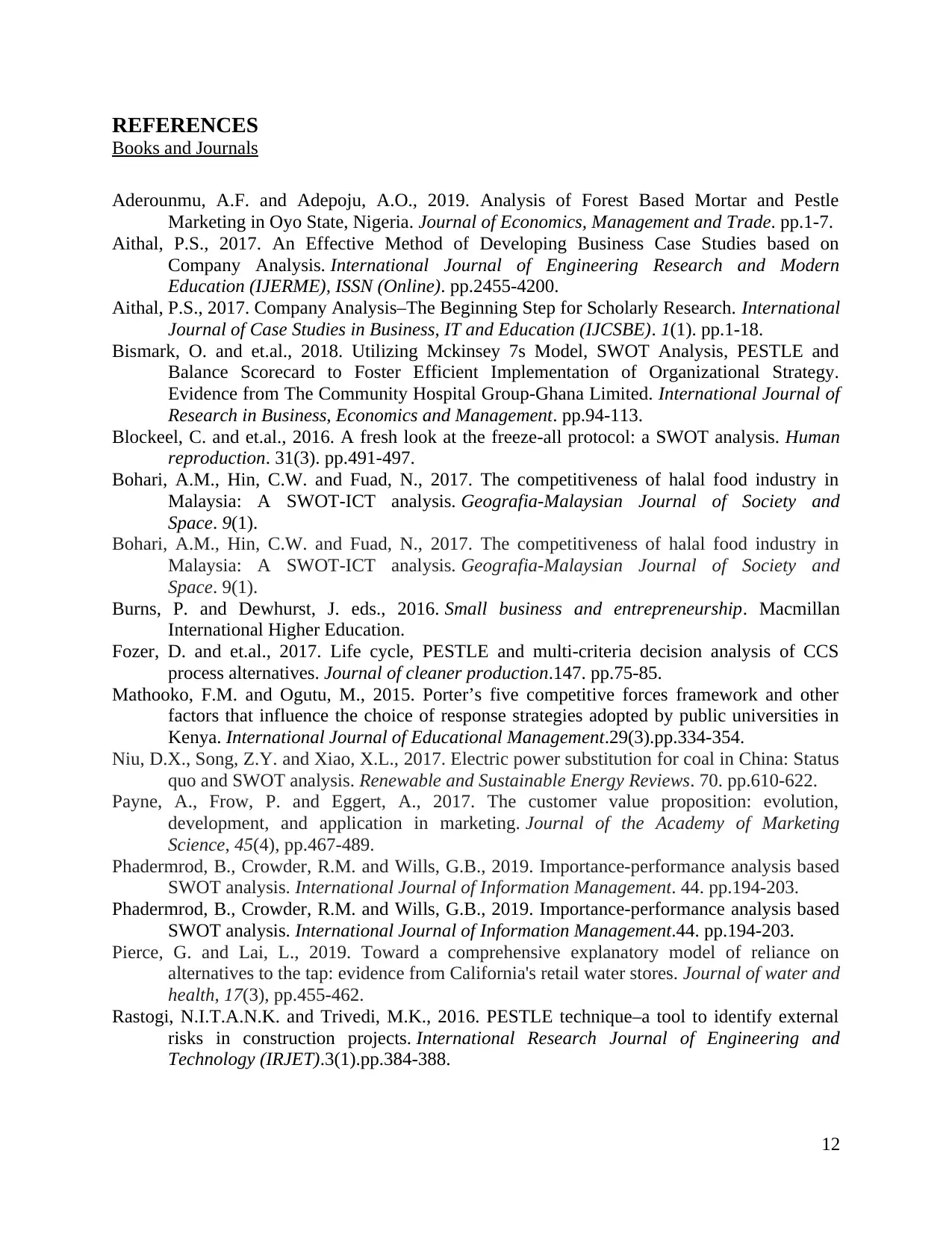
REFERENCES
Books and Journals
Aderounmu, A.F. and Adepoju, A.O., 2019. Analysis of Forest Based Mortar and Pestle
Marketing in Oyo State, Nigeria. Journal of Economics, Management and Trade. pp.1-7.
Aithal, P.S., 2017. An Effective Method of Developing Business Case Studies based on
Company Analysis. International Journal of Engineering Research and Modern
Education (IJERME), ISSN (Online). pp.2455-4200.
Aithal, P.S., 2017. Company Analysis–The Beginning Step for Scholarly Research. International
Journal of Case Studies in Business, IT and Education (IJCSBE). 1(1). pp.1-18.
Bismark, O. and et.al., 2018. Utilizing Mckinsey 7s Model, SWOT Analysis, PESTLE and
Balance Scorecard to Foster Efficient Implementation of Organizational Strategy.
Evidence from The Community Hospital Group-Ghana Limited. International Journal of
Research in Business, Economics and Management. pp.94-113.
Blockeel, C. and et.al., 2016. A fresh look at the freeze-all protocol: a SWOT analysis. Human
reproduction. 31(3). pp.491-497.
Bohari, A.M., Hin, C.W. and Fuad, N., 2017. The competitiveness of halal food industry in
Malaysia: A SWOT-ICT analysis. Geografia-Malaysian Journal of Society and
Space. 9(1).
Bohari, A.M., Hin, C.W. and Fuad, N., 2017. The competitiveness of halal food industry in
Malaysia: A SWOT-ICT analysis. Geografia-Malaysian Journal of Society and
Space. 9(1).
Burns, P. and Dewhurst, J. eds., 2016. Small business and entrepreneurship. Macmillan
International Higher Education.
Fozer, D. and et.al., 2017. Life cycle, PESTLE and multi-criteria decision analysis of CCS
process alternatives. Journal of cleaner production.147. pp.75-85.
Mathooko, F.M. and Ogutu, M., 2015. Porter’s five competitive forces framework and other
factors that influence the choice of response strategies adopted by public universities in
Kenya. International Journal of Educational Management.29(3).pp.334-354.
Niu, D.X., Song, Z.Y. and Xiao, X.L., 2017. Electric power substitution for coal in China: Status
quo and SWOT analysis. Renewable and Sustainable Energy Reviews. 70. pp.610-622.
Payne, A., Frow, P. and Eggert, A., 2017. The customer value proposition: evolution,
development, and application in marketing. Journal of the Academy of Marketing
Science, 45(4), pp.467-489.
Phadermrod, B., Crowder, R.M. and Wills, G.B., 2019. Importance-performance analysis based
SWOT analysis. International Journal of Information Management. 44. pp.194-203.
Phadermrod, B., Crowder, R.M. and Wills, G.B., 2019. Importance-performance analysis based
SWOT analysis. International Journal of Information Management.44. pp.194-203.
Pierce, G. and Lai, L., 2019. Toward a comprehensive explanatory model of reliance on
alternatives to the tap: evidence from California's retail water stores. Journal of water and
health, 17(3), pp.455-462.
Rastogi, N.I.T.A.N.K. and Trivedi, M.K., 2016. PESTLE technique–a tool to identify external
risks in construction projects. International Research Journal of Engineering and
Technology (IRJET).3(1).pp.384-388.
12
Books and Journals
Aderounmu, A.F. and Adepoju, A.O., 2019. Analysis of Forest Based Mortar and Pestle
Marketing in Oyo State, Nigeria. Journal of Economics, Management and Trade. pp.1-7.
Aithal, P.S., 2017. An Effective Method of Developing Business Case Studies based on
Company Analysis. International Journal of Engineering Research and Modern
Education (IJERME), ISSN (Online). pp.2455-4200.
Aithal, P.S., 2017. Company Analysis–The Beginning Step for Scholarly Research. International
Journal of Case Studies in Business, IT and Education (IJCSBE). 1(1). pp.1-18.
Bismark, O. and et.al., 2018. Utilizing Mckinsey 7s Model, SWOT Analysis, PESTLE and
Balance Scorecard to Foster Efficient Implementation of Organizational Strategy.
Evidence from The Community Hospital Group-Ghana Limited. International Journal of
Research in Business, Economics and Management. pp.94-113.
Blockeel, C. and et.al., 2016. A fresh look at the freeze-all protocol: a SWOT analysis. Human
reproduction. 31(3). pp.491-497.
Bohari, A.M., Hin, C.W. and Fuad, N., 2017. The competitiveness of halal food industry in
Malaysia: A SWOT-ICT analysis. Geografia-Malaysian Journal of Society and
Space. 9(1).
Bohari, A.M., Hin, C.W. and Fuad, N., 2017. The competitiveness of halal food industry in
Malaysia: A SWOT-ICT analysis. Geografia-Malaysian Journal of Society and
Space. 9(1).
Burns, P. and Dewhurst, J. eds., 2016. Small business and entrepreneurship. Macmillan
International Higher Education.
Fozer, D. and et.al., 2017. Life cycle, PESTLE and multi-criteria decision analysis of CCS
process alternatives. Journal of cleaner production.147. pp.75-85.
Mathooko, F.M. and Ogutu, M., 2015. Porter’s five competitive forces framework and other
factors that influence the choice of response strategies adopted by public universities in
Kenya. International Journal of Educational Management.29(3).pp.334-354.
Niu, D.X., Song, Z.Y. and Xiao, X.L., 2017. Electric power substitution for coal in China: Status
quo and SWOT analysis. Renewable and Sustainable Energy Reviews. 70. pp.610-622.
Payne, A., Frow, P. and Eggert, A., 2017. The customer value proposition: evolution,
development, and application in marketing. Journal of the Academy of Marketing
Science, 45(4), pp.467-489.
Phadermrod, B., Crowder, R.M. and Wills, G.B., 2019. Importance-performance analysis based
SWOT analysis. International Journal of Information Management. 44. pp.194-203.
Phadermrod, B., Crowder, R.M. and Wills, G.B., 2019. Importance-performance analysis based
SWOT analysis. International Journal of Information Management.44. pp.194-203.
Pierce, G. and Lai, L., 2019. Toward a comprehensive explanatory model of reliance on
alternatives to the tap: evidence from California's retail water stores. Journal of water and
health, 17(3), pp.455-462.
Rastogi, N.I.T.A.N.K. and Trivedi, M.K., 2016. PESTLE technique–a tool to identify external
risks in construction projects. International Research Journal of Engineering and
Technology (IRJET).3(1).pp.384-388.
12
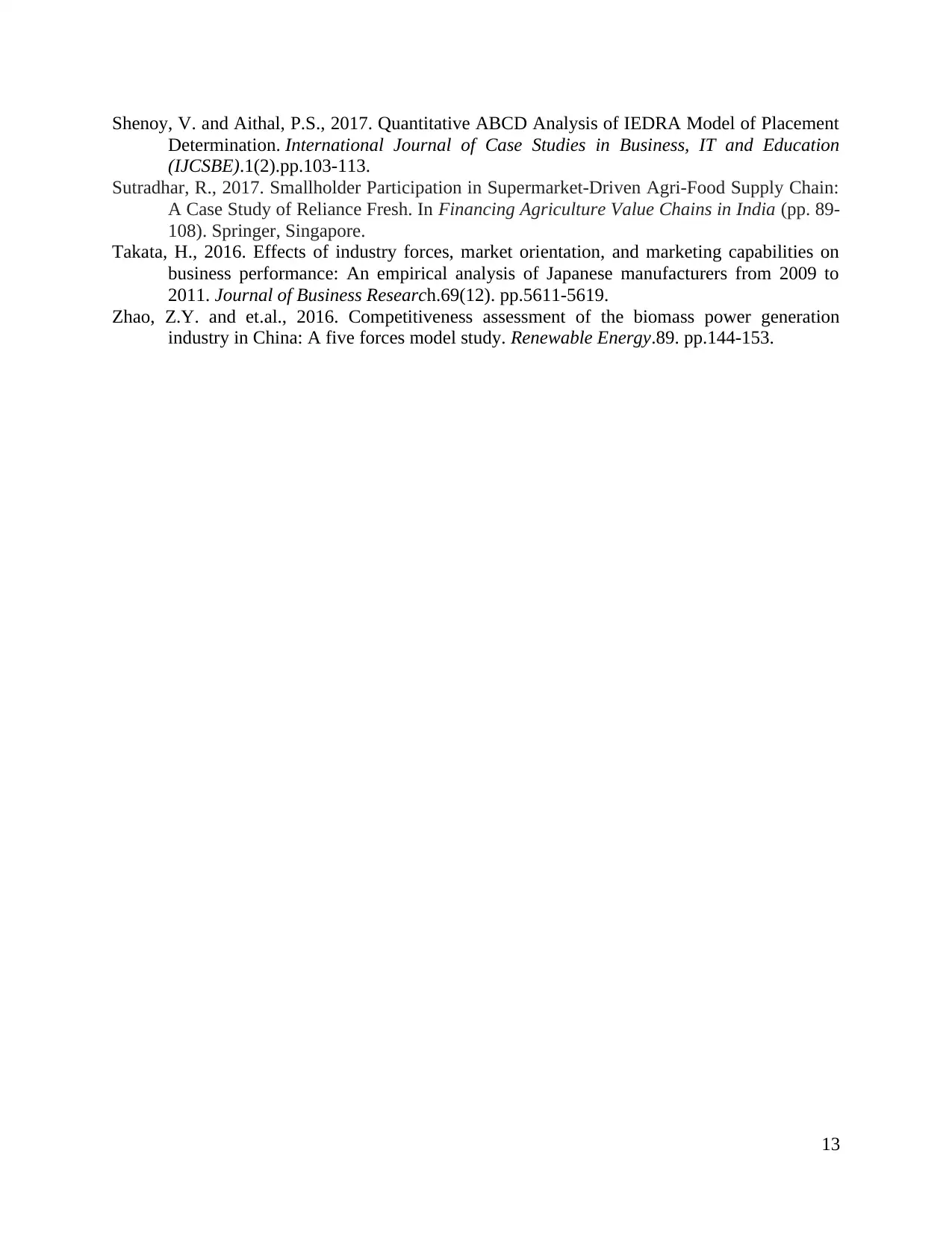
Shenoy, V. and Aithal, P.S., 2017. Quantitative ABCD Analysis of IEDRA Model of Placement
Determination. International Journal of Case Studies in Business, IT and Education
(IJCSBE).1(2).pp.103-113.
Sutradhar, R., 2017. Smallholder Participation in Supermarket-Driven Agri-Food Supply Chain:
A Case Study of Reliance Fresh. In Financing Agriculture Value Chains in India (pp. 89-
108). Springer, Singapore.
Takata, H., 2016. Effects of industry forces, market orientation, and marketing capabilities on
business performance: An empirical analysis of Japanese manufacturers from 2009 to
2011. Journal of Business Research.69(12). pp.5611-5619.
Zhao, Z.Y. and et.al., 2016. Competitiveness assessment of the biomass power generation
industry in China: A five forces model study. Renewable Energy.89. pp.144-153.
13
Determination. International Journal of Case Studies in Business, IT and Education
(IJCSBE).1(2).pp.103-113.
Sutradhar, R., 2017. Smallholder Participation in Supermarket-Driven Agri-Food Supply Chain:
A Case Study of Reliance Fresh. In Financing Agriculture Value Chains in India (pp. 89-
108). Springer, Singapore.
Takata, H., 2016. Effects of industry forces, market orientation, and marketing capabilities on
business performance: An empirical analysis of Japanese manufacturers from 2009 to
2011. Journal of Business Research.69(12). pp.5611-5619.
Zhao, Z.Y. and et.al., 2016. Competitiveness assessment of the biomass power generation
industry in China: A five forces model study. Renewable Energy.89. pp.144-153.
13
1 out of 15
![[object Object]](/_next/static/media/star-bottom.7253800d.svg)





